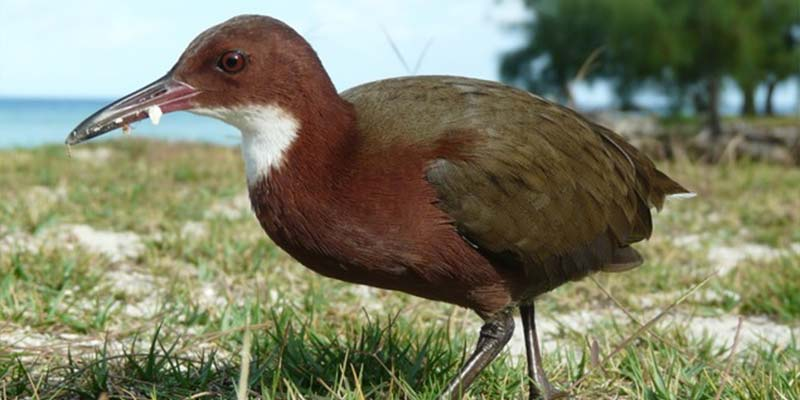Description

Copyright infringement not intended
Picture Courtesy: https://www.manoramayearbook.in/current-affairs/world/2019/05/11/Flightless-bird-returns-from-the-dead.html
Context: The Aldabra rail species, a flightless subspecies of the white-throated rail, went extinct due to the submersion of the Aldabra atoll off the southeast coast of Africa. The atoll was submerged beneath the waves for a significant period (around 136,000 to 118,000 years ago), causing a turnover in the fauna and leading to the extinction of the flightless rail.
About Aldabra Rail
Appearance
- About the size of a chicken, with a stocky build and short legs.
- Plumage is mainly brown and gray, with a rusty-red head and chest and a white throat.
- Short wings, which are incapable of flight.
- Strong legs and feet, adapted for running and foraging on the ground.
Habitat
- Found only on the Aldabra Atoll, a remote group of islands in the Indian Ocean, north of Madagascar.
- Inhabits dense forests, scrublands, and mangroves.
- Prefers areas with plenty of ground cover, where it can hide from predators.

Diet
- Omnivorous, feeding on a variety of invertebrates, fruits, and seeds.
- Uses its strong beak to probe the ground for food.
- Eat small reptiles and amphibians.
Behaviour
- Solitary birds, except during breeding season.
- Ground-dwelling, spending most of their time foraging on the forest floor.
- Can run quickly and swim if necessary.
- Vocal birds, with a variety of calls and songs.
Reproduction
- Breeds monogamously, with pairs defending their territories.
- The female lays 2-4 eggs in a nest on the ground.
- Both parents incubate the eggs and care for the chicks.
- Chicks are precocial, able to walk and feed themselves soon after hatching.
Evolutionary history
- The Aldabra rail is a subspecies of the white-throated rail, which is found on Madagascar and other islands in the Indian Ocean.
- The white-throated rail is capable of flight, but the Aldabra rail lost its ability to fly due to the lack of predators on the Aldabra Atoll.
- This is an example of iterative evolution, where a population evolves in a similar way to an extinct ancestor.
- Fossil evidence suggests that there was a flightless rail on the Aldabra Atoll about 136,000 years ago, which went extinct when the atoll was submerged by rising sea levels.
- The atoll later re-emerged, and the white-throated rail recolonized it.
- The recolonized population eventually evolved into the modern Aldabra rail, losing its ability to fly once again.

Conservation status
- The Aldabra rail is classified as Least Concern by the IUCN, but it is threatened by habitat loss and introduced predators.
- Conservation efforts are underway to protect the Aldabra Atoll and its unique wildlife.
|
Interesting facts
●The Aldabra rail is the only living flightless bird in the Indian Ocean.
●It is one of the few examples of iterative evolution in the animal kingdom.
●The Aldabra rail is an important part of the Aldabra Atoll ecosystem, helping to control insect populations and disperse seeds.
|
|
PRACTICE QUESTION
Q. Why is the Aldabra rail making headlines?
A) Breakthrough in avian genetics
B) Rediscovery after presumed extinction
C) Unprecedented migratory patterns
D) Successful cloning experiment
Answer: B
Explanation:
The Aldabra rail is in the news for its rediscovery after presumed extinction, showcasing its unique evolutionary journey of becoming flightless twice.
|












